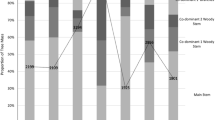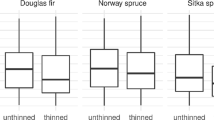Abstract
Key message
During pruning, shortening branches to decrease crown size significantly affected the vibration properties and mass of trees, but the progressive removal of lower branches only altered mass—not vibration properties.
Abstract
During pruning, arborists often intend to increase a tree’s resistance to wind loading by selectively removing branches, but there are few studies examining the efficacy of these interventions, especially for large, open-grown trees. This study examined the vibration properties (frequency and damping ratio) and mass of Senegal mahogany (Khaya senegalensis) and rain tree (Samanea saman) before and after a series of pruning treatments: crowns were either raised or reduced at incremental severities between 0 and 80%. For both species, mass decreased faster on reduced than raised trees. The frequency and damping ratio of trees varied with the severity of pruning for reduced, but not raised, trees. The frequency of reduced trees generally increased with pruning severity. In contrast, damping ratio of reduced trees generally decreased with the severity of pruning, except for the unique increase in damping ratio on Senegal mahoganies reduced by 10–20%. Although the vibration properties and mass will change as trees grow after pruning, the results suggest that arborists can reduce trees to change their vibration properties and concomitant response to wind loads, but arborists should reduce trees by a small amount to avoid the adverse decrease in damping ratio.









Similar content being viewed by others
References
Anten NPR, Barton KE, Boege K et al (2011) Size- and age-related changes to tree structure and function. Springer, Dordrecht
ASTM (2014) Standard test methods for density and specific gravity (relative density) of wood and wood-based materials. ASTM International, West Conshohocken
Bruchert F, Gardiner BA (2006) The effect of wind exposure on the tree aerial architecture and biomechanics of Sitka spruce (Picea sitchensis, Pinaceae). Am J Bot 93:1512–1521
Bruchert F, Becker G, Speck T (2000) The mechanics of Norway spruce [Picea abies (L.) Karst]: mechanical properties of standing trees from different thinning regimes. For Ecol Manag 135:45–62
Cannell MGR, Morgan J (1987) Young’s modulus of sections of living branches and tree trunks. Tree Physiol 3:355–364
Chave J, Coomes DA, Jansen S et al (2009) Towards a worldwide wood economics spectrum. Ecol Lett 12:351–366
Gilman EF, Lilly SJ (2008) Tree Pruning, 2nd edn. International Society of Arboriculture, Champaign
Gilman EF, Grabosky JC, Jones S, Harchick C (2008a) Effects of pruning dose and type on trunk movement in tropical storm winds. Arboricult Urban For 34:13–19
Gilman EF, Masters F, Grabosky JC (2008b) Pruning affects tree movement in hurricane force wind. Arboricult Urban For 34:20–28
Glass SV, Zelinka SL (2010) Moisture relations and physical properties of wood. In: Centennial, ed. Forest Products Laboratory, Madison, pp 4–1
James KR (2014) A study of branch dynamics on an open-grown tree. Arboricult Urban For 40:125–134
Jonsson MJ, Foetzki A, Kalberer M et al (2007) Natural frequencies and damping ratios of Norway spruce (Picea abies (L.) Karst) growing on subalpine forested slopes. Trees Struct Funct 21:541–548
Kane B (2008) Tree failure following a windstorm in Brewster, Massachusetts, USA. Urban For Urban Green 7:15–23
Kane B (2014) Determining parameters related to the likelihood of failure of red oak (Quercus rubra L.) from winching tests. Trees Struct Funct 28:1667–1677
Kane B (2018) The effect of simulated trunk splits, pruning, and cabling on sways of Quercus rubra L. Trees Struct Funct 32:985–1000. https://doi.org/10.1007/s00468-018-1690-3
Kane B, James KR (2011) Dynamic properties of open-grown deciduous trees. Can J For Res 41:321–330
Kane B, Smiley ET (2006) Drag coefficients and crown area estimation of red maple. Can J For Res 36:1951–1958
Kane B, Pavlis M, Harris JR, Seiler JR (2008) Crown reconfiguration and trunk stress in deciduous trees. Can J For Res 38:1275–1289
Kretschmann DE (2010) Mechanical properties of wood. In: Centennial ed. Forest Products Laboratory, Madison, pp 5.1-5.44
Lundstrom T, Stoffel M, Stockli V (2008) Fresh-stem bending of silver fir and Norway spruce. Tree Physiol 28:355–366
Miesbauer JW, Gilman EF, Giurcanu M (2014) Effects of tree crown structure on dynamic properties of Acer rubrum L. ‘Florida Flame’™. Arboric Urban For 40:218–229
Milne R (1991) Dynamics of swaying Picea sitchensis. Tree Physiol 9:383–399
Milne R, Blackburn P (1989) The elasticity and vertical distribution of stress within stems of Picea sitchensis. Tree Physiol 5:195–205
Moore JR, Maguire DA (2004) Natural sway frequencies and damping ratios of trees: concepts, review and synthesis of previous studies. Trees Struct Funct 18:195–203
Moore JR, Maguire DA (2005) Natural sway frequencies and damping ratios of trees: influence of crown structure. Trees Struct Funct 19:363–373
Niklas KJ (1992) Plant biomechanics: an engineering approach to plant form and function, 1st edn. University of Chicago Press, Chicago
Oliver HR (1971) Wind profiles in and above a forest canopy. Q J R Meteorol Soc 97:548–553
Pavlis M, Kane B, Harris JR, Seiler JR (2008) The effects of pruning on drag and bending moment of shade trees. Arboricult Urban For 34:207–215
Peltola H, Kellomaki S, Hassinen A, Granander M (2000) Mechanical stability of Scots pine, Norway spruce and birch: an analysis of tree-pulling experiments in Finland. For Ecol Manag 135:143–153
Sellier D, Fourcaud T (2005) A mechanical analysis of the relationship between free oscillations of Pinus pinaster Ait. saplings and their aerial architecture. J Exp Bot 56:1563–1573
Smiley ET, Kane B (2006) The effects of pruning type on wind loading of Acer rubrum. Arboricult Urban For 32:33–40
Spatz HC, Bruchert F, Pfisterer J (2007) Multiple resonance damping or how do trees escape dangerously large oscillations? Am J Bot 94:1603–1611
TCIA (2017) American National Standard for tree care operations—tree, shrub, and other woody plant management—standard practices (Pruning). Tree Care Industry Association Inc, Londonderry
Vollsinger S, Mitchell SJ, Byrne KE et al (2005) Wind tunnel measurements of crown streamlining and drag relationships for several hardwood species. Can J For Res 35:1238–1249
Acknowledgements
The authors wish to gratefully acknowledge assistance with data collection from N. Abarrientos, C. Lee, S. Lim, L. Sheehan, Yeo Y.P., and Chong Y.H. We also appreciate the insightful and constructive comments of two anonymous reviewers on a previous version of this paper.
Funding
This work was supported by the National Parks Board, Singapore.
Author information
Authors and Affiliations
Contributions
DB and BK conceived and designed the study, DB collected and analyzed the data, DB wrote the manuscript, and all authors edited the manuscript.
Corresponding author
Ethics declarations
Conflict of interest statement
The authors declare that they have no conflict of interest.
Additional information
Communicated by Speck.
Publisher's Note
Springer Nature remains neutral with regard to jurisdictional claims in published maps and institutional affiliations.
Electronic supplementary material
Below is the link to the electronic supplementary material.
Rights and permissions
About this article
Cite this article
Burcham, D.C., Autio, W.R., James, K. et al. Effect of pruning type and severity on vibration properties and mass of Senegal mahogany (Khaya senegalensis) and rain tree (Samanea saman). Trees 34, 213–228 (2020). https://doi.org/10.1007/s00468-019-01912-8
Received:
Accepted:
Published:
Issue Date:
DOI: https://doi.org/10.1007/s00468-019-01912-8




